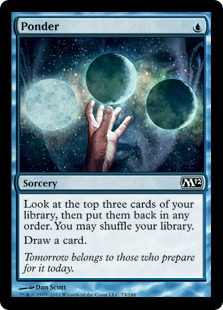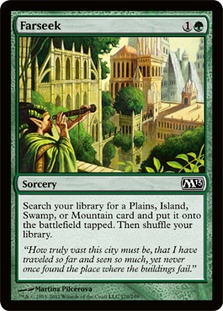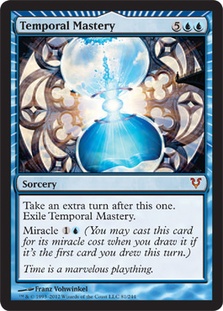I had a tournament report in mind when I sat down to write for this week. I placed first at the StarCityGames.com Standard Open in Washington, DC this past weekend with Wolf Run Blue, a deck that’s fresh, fun, and powerful. A few rounds into the play by play, though, I realized that my effort of a thousand words had accomplished little more than copying and pasting two lines of text would have.
Power
The beauty of Wolf Run Blue and the reason it allowed me to win a tournament as large and diverse as the StarCityGames.com Standard Open in Washington, DC is its streamlined and consistent game plan. Each and every card in the deck works towards the goal of surviving to cast a Titan, and they do their jobs well. More important is the fact that this game plan, if executed successfully, trumps nearly everything else that’s possible in Standard. When Wolf Run Blue does what it sets out to do, it often doesn’t matter what cards your opponent has drawn or played throughout the course of the game.
The most memorable game of the tournament for me was game 2 of my quarterfinals match against Ian Shore. Since I had seen Ian’s Naya Pod decklist, before ending each of my turns I would stop and try to imagine the most devastating play Ian could make when he untapped. Each turn, my grim prediction would come true and Ian would make the best play I could think of given the 75 cards available to him.
Often it can be a frustrating and discouraging feeling to face down an opponent’s "nut draw." In this case, however, I was feeling pride and satisfaction because I myself had a strong draw. At every turn I was able to keep pace, and eventually I was able to turn things around and take them game.
Now, Naya Pod is a very brutal and punishing deck, and my intent is not to make it sound like Wolf Run Blue has a 100% matchup. However, it is capable of getting draws that Naya opponents cannot beat no matter how tightly they play or how fortunately they draw. This "nut draw versus nut draw advantage" is an intangible quality of a deck that I highly value. As I demonstrated last weekend, Wolf Run Blue is a good deck to "run good" with; there’s little anyone can do to stop you.
I feel that Wolf Run Blue has the "nut draw versus nut draw advantage" against nearly every deck in Standard, with some obscure exceptions like Infect and Frites. A perfect draw from Wolf Run Blue should beat Birthing Pod, it should beat Delver, it should beat Zombies, and it should win the Wolf Run mirror. The deck has this quality thanks to cards like Cavern of Souls, Bonfire of the Damned, Thragtusk, and Primeval Titan which, when operating at their maximum potential, are virtually unstoppable.
Consistency
What I’ve described above is one valuable quality of Wolf Run Blue, but it alone does not make it a great deck. There’s a reason why decks of one Black Lotus, one Channel, one Fireball, and 57 Mountains don’t win Vintage tournaments. Such a deck would be bad because it lacks library manipulation, redundancy, and cards that are powerful on their own. Wolf Run Blue has all of these things.
The legendary Charles Gindy in his Top 8 profile for the event named Ponder as the best card in Standard. Ponder’s ability to smooth out the early turns and dig for power in the late game makes it a welcome addition to just about any deck. It’s especially perfect for the Wolf Run strategy, though. For one thing, Wolf Run is a single-minded deck that wants to cast a specific type of card on each turn of the game. For the modest investment of one mana, you can substantially increase your chances of making your land drops and hitting the proper cards at the proper times. Second, Wolf Run has an abundance of ways to shuffle its library, so Ponder often feels more like an Impulse, though with the added bonus of being able to keep more than one card if you really want to. Finally, the particular list of Wolf Run Ramp that I played had seven miracle spells to set up with Ponder.
By now, Standard’s card pool has become deep enough that you can play multiple cards to do every job that needs to be done. Farseeks serve as Rampant Growths five through eight. Didn’t draw a Solemn Simulacrum? Snapcaster last turn’s Rampant Growth. Four Primeval Titans not enough? Splash into Thragtusks and Frost Titans. If you’re truly a fiend for redundancy and consistency, feel free to play two Green Sun’s Zeniths and a Birds of Paradise to serve as both extra mana and extra Titans.
As a commentator at StarCityGames.com Open Series: Buffalo, Patrick Chapin astutely described Wolf Run as a "combo deck." Like other combo decks, it’s a strategy where you tenaciously work towards your own goal and try to build your deck in a way that prevents your opponent from interacting with you whenever possible. The difference, however, is that Wolf Run’s combo is only a single card: a Titan. There are no Voltaic Keys or Pacts of the Titan to weight down your hands while you wait to draw your combo. Wolf Run is full of Titans, Thragtusks, and Bonfires of the Damned, all of which are devastating topdecks in the mid and late game and can go a long way towards winning a game on their own.
The Decklist
These are the general qualities that make Wolf Run Blue a great choice for a large tournament in an unknown field. But let’s get down to the exact decklist I played at the tournament.
Creatures (14)
Lands (26)
Spells (20)
Sideboard

The Mana Base
There are a few uncertainties about the mana base. I argued a lot about it with Gerard Fabiano and Josh Ravitz, who helped me with the deck. The challenge is to find the balance of power and consistency, as described above. You need to cast your spells on time, and you typically cannot keep a hand without green mana, so you want as many colored mana sources as possible. However, each colorless value land you add increases the power of your deck and raises the chances that a Primeval Titan will lead to a win. Josh chose to address this problem by playing a few Sphere of the Suns since it can be cast without green mana, but it’s certainly a much weaker card than Farseek. Personally, I feel that thirteen green lands is the sweet spot. Cutting to twelve would be too greedy; adding a fourteenth would be more comfortable, but it would unnecessarily reduce the power level of the deck.
I wouldn’t cut below five Farseek targets as long as I am playing four copies of the card. Against Delver, I swap an Island for a Cavern of Souls, but I always cut one of the Farseeks when I do so.
I was never punished by my decision to cut down to only a single Inkmoth Nexus and a single Kessig Wolf Run. Your poison wins are few and far between, but that’s the way it should be. Why not just kill them with a Titan?! However, if people react to the publishing of my DC decklist with the idea that they can simply Ghost Quarter the one Wolf Run, it’s a good idea to level them by sideboarding a second copy.
Four Glimmerposts is not up for debate; I would cut the blue before I would cut the Glimmerposts. Against pure control, you can sideboard two out for two Cavern of Souls, but they’re far too important against Delver, Zombies, and Birthing Pod to not play four maindeck.
Cavern of Souls is similarly awesome. I can’t believe I ever tried to play the deck without four! Unlike Glimmerpost, though, the Caverns can be split however you like between maindeck and sideboard.
The Creatures
Solemn Simulacrum is a great card for the deck but is very inconvenient to draw in multiples. I’d rather draw my first Solemn than my first Snapcaster, but Snapcaster will never be bad while Solemn is a weak play on any turn besides the one where you hit four mana. In DC I replaced the fourth Solemn with a Snapcaster Mage, and I’d even take it a step further and two and two for next time.
At worst, Snapcaster Mage can be a weaker Solemn, flashing back Rampant Growth or Farseek. It has the added flexibility, though, of being able to reuse a Ponder, a board sweeper, or a sideboard card. This one time I’ll have to differ with the esteemed Mr. Gindy and say that Snapcaster Mage is the best card in Standard. I’m happy to have him on my team.
Next, we come to the other little (not so little) blue creature in the deck: Phantasmal Image. Unlike other Wolf Run players, I did not maindeck Whipflare or Slagstorm, so an extra answer to Geist of Saint Traft is very welcome. Image will always find a good target against Pod or a Wolf Run mirror and will quickly outperform its modest mana cost. Finally, let’s not forget that Wolf Run Blue plays six Titans of its own! My personal favorite play is Imaging a Frost Titan to truly lock them down and out of the game. That said, two is the perfect number, as it sometimes takes some set up before it can really contribute to the deck’s primary game plan.
Primeval Titan is the deck’s key card. Frost Titan is my backup of choice since it’s a little better against Zealous Conscripts than Inferno Titan and a little better against Vapor Snag than Wurmcoil Engine and Consecrated Sphinx. It’s also very good with Temporal Mastery, as every permanent you tap down over the course of your extended turn will stay tapped. However, two felt like the right number to me. The goal of deck is to hit six mana on turn 6, but that doesn’t mean you should ignore mana curve and play an unreasonable number of six-drop creatures.
Thragtusk is a huge addition to Wolf Run as a deck, as I explained last week. It buys you a ton of time to impose your unbeatable late game and can be a win condition on its own against control or Delver (especially in conjunction with Cavern of Souls). Thragtusk beatdown is one reason I could definitely support playing a second Kessig Wolf Run just to draw naturally. Huntmaster of the Fells is a fine card but is simply much weaker than Thragtusk, so I wouldn’t recommend it.
The Spells
I’d love to find room for five maindeck sweepers, but I’m at a loss for what to cut. Given the small number of them in the maindeck, I want them to be as high impact as possible, leaving Whipflare as only a sideboard card. Blasphemous Act is okay, especially if Hero of Bladehold becomes a format-defining card again (as it likely will). However, Bonfire of the Damned is simply a better card, and I regretted that I splashed into Act before playing the full playset of Bonfires.
Though I often sideboard out Temporal Mastery, it is a very good maindeck card. You can’t just maindeck a million sweepers and Thragtusks because, believe it or not, there are some decks out there that these cards are not good against. If you miracle Mastery in the early game, it’s substantially better than Explore (since you get to untap and cast another spell), and Explore is already a card I’d love to play in this deck. It also means that your opponent can never ever ever let you untap with a Titan in play. If you pick up Wolf Run Blue right away, you’ll still get a lot of undeserved wins because of your opponents not giving Temporal Mastery the respect it deserves. I also feel that its presence gives you a dramatic advantage in the Wolf Run pseudo-mirror.
The Sideboard
Overall, I was pretty happy with my sideboard for this tournament, but there might be room for a few improvements. Believe it or not, I didn’t use my Beast Withins or Karn Liberated a single time over the course of the event (the sleeves are still shiny enough to see your face in). However, they’ll earn their spot if the Wolf Run mirror becomes popular again.
Crushing Vines is one of the best cards against the Delver lists I tested against (see Ben Lundquist deck). However, there were two times in the tournament where I was embarrassed that I had gone so overboard on them. The first time was against G/R Aggro, where I not only needed an answer to Sword of War and Peace but also wanted insurance against Manabarbs! One copy of Natural End would have been great there. The second was in the finals against Charles Gindy; his Delver deck had no Restoration Angels and instead played the devastating Hero of Bladehold. I wished there that I had one Combust.
There’s no reason to keep the Negates in the sideboard unless you specifically expect to face control.
Part of my goal in this article was to encourage you to play around a little bit with the Wolf Run Blue archetype. I’ve shared my opinions on which slots are flexible and which are not. However, I’ll also close by offering you the changes that I would make if I was to play this deck in an event this weekend (which I certainly would if I had one to play).
-1 Solemn Simulacrum, +1 Snapcaster Mage
-1 Blasphemous Act, +1 Bonfire of the Damned
-2 Negate, +1 Kessig Wolf Run, +1 Inkmoth Nexus
-1 Crushing Vines, +1 Combust
Best of luck!




